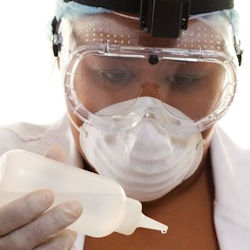Risk of Exposure to Biological Agents
Various industries present unique biological hazards during the normal course of work.
There are over 190 important biological agents that may be infectious, allergenic, toxic, or carcinogenic in the workplace. Many occupational groups are exposed to these biohazards, but risk may be greatest among:
- health care and laboratory workers, and
- agricultural, forestry, and fishing industry workers.
We have listed industries below that typically experience exposure to biohazards.
The food industry includes cheese, yogurt, salami or food additive production, and bakeries.
There is a risk of exposure to:
- Molds/yeasts, bacteria and mites cause allergies
- Organic dusts of grain, milk powder or flour contaminated with biological agents
- Toxins such as botulinustoxins or aflatoxins
Preventive measures include:
- Closed processes
- Avoid aerosol formation
- Separate contaminated work areas
- Appropriate hygiene measures
There is a risk of exposure to:
- Several viral and bacterial infections such as HIV, hepatitis, or tuberculosis
- Needlestick injuries
Preventive measures include:
- Safe handling of infectious specimens, sharps waste, contaminated linen and other material
- Safe handling and cleaning of blood spills and other body fluids
- Adequate protective equipment, gloves, clothing, glasses
- Appropriate hygienic measures
There is a risk of exposure to:
- Infections and allergies when handling microorganisms and cell cultures (human tissues)
- Accidental spills and needlestick injuries
Preventive measures include:
- Microbiological safety cabinets
- Dust and aerosol-reducing measures
- Safe handling and transport of samples
- Appropriate personal protection and hygiene measures
- Decontamination and emergency measures for spills
- Restricted access
- Biosafety labels
Agriculture includes forestry, horticulture, and animal and fodder production
There is a risk of exposure to:
- Bacteria, fungi, mites, and viruses transmitted from animals, parasites and ticks
- Respiratory problems due to microorganisms and mites in organic dusts of grain, mild powder, flour, or spices
- Specific allergic diseases like farmer's lung and bird breeder's lung
Preventive measures include:
- Dust and aerosol-reducing measures
- Avoid contact with contaminated animal or equipment
- Protection against animal bites and stings
- Preservatives for fodder
- Cleaning and maintenance
There is a risk of exposure to:
- Skin problems due to bacteria
- Bronchial asthma due to molds/yeasts in circulating fluids in industrial processes such as grinding, pulp factories, and metal and stone cutting fluids
Preventive measures include:
- Local exhaust ventilation
- Regular maintenance, filtering, and decontamination of fluids and machinery
- Skin protection
- Appropriate hygiene measures
These industries typically require working in air-conditioned environments and high humidity.
There is a risk of exposure to:
- Allergies and respiratory disorders due to molds/yeasts
- Legionnaires disease
Preventive measures include:
- Dust- and aerosol-reducing measures
- Regular maintenance of ventilation, machinery, and work areas
- Restrict number of workers
- Maintaining high hot (tap) water temperatures
There is a risk of exposure to:
Molds/yeasts and bacteria cause allergies and respiratory disorders.
Preventive measures include:
- Dust- and aerosol-reduction
- Decontamination
- Adequate personal protective equipment
This category includes processing natural materials like clay, straw, reed; redevelopment of buildings.
There is a risk of exposure to:
Molds and bacteria due to deterioration of building materials.
Preventive measures include:
- Dust- and aerosol-reducing measures
- Appropriate personal protection and hygiene measures
Knowledge Check Choose the best answer for the question.
4-5. The risk of exposure to biohazards may be greatest in the _____.
You forgot to answer the question!

